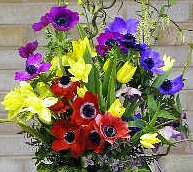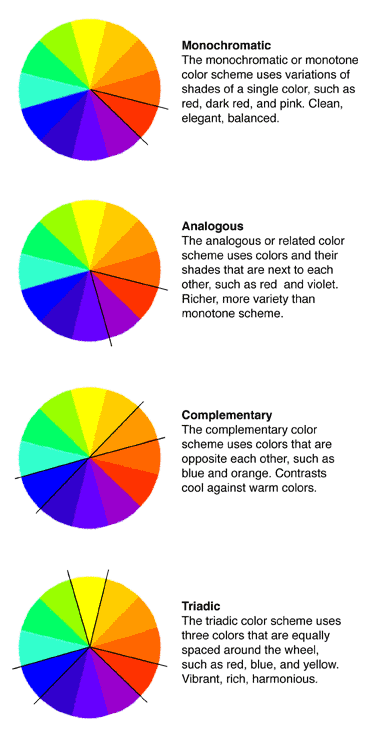Floral Arrangement Tips:
Easy Guide to Spectacular
Color Combinations

These floral arrangement tips can help you create spectacular color
combinations, IMMEDIATELY. You'll see how to use the color wheel like a
pro, and you'll learn basic color theory, too — monochromatic,
analogous, complementary and triadic color schemes await you.
Relax, it's easy to come up with great color combinations for any kind of flower arrangement!
You can begin by deciding if there is to be a main color for your floral
arrangement, then build upon it. Single color floral designs are fine,
but a color-coordinated arrangement has extra appeal.
Below are some color suggestions to get you started. Use some or all colors of a group as you wish.
- Black / grey / silver / white
OPTION: For contrast, you can add one other color to this group
(e.g. red or blue)
- Blue / peach / orange / yellow / white
- Red / blue / purple / pink / white
- Orange / red / yellow / brown / white
Pretty easy, right?
Now, let's take a look at how floral professionals might choose their color scheme.
Floral Arrangement Tips:
How to Use the Color Wheel
The
color wheel illustrations below will ease you into basic color theory
with a demonstration of monochromatic, analogous, complementary and
triadic color combinations. (Watch the eyebrows raise when you toss off
these phrases on your next visit to the florist!)

Once you understand these basic color combinations, there are many variations you can experiment with in a flower arrangement.
Color Wheel Combinations

Take another look at this flower arrangement (design by Chrissie Harten).
This
mound design is a perfect example of using a Triadic color scheme (red,
blue, yellow) combined with a touch of the Analogous (purple, which is
right next to red on the color wheel).
See how easy that was? And it looks great!
Let's have some fun and expand on that idea.
Think
about this: you can further combine the Analogous and Triadic color
harmonies to create a breathtaking floral design that will bring
compliments galore.
Here's what I mean...
Take the main
TRIADIC colors - blue, red and yellow. It's a simple step to extend the
range with shades of all three colors (ANALOGOUS).
- Dark blue, medium blue, light blue
- Purple, red, pink
- Dark yellow, light yellow
- add some browns, as in sunflowers or twigs and branches
All
these colors can be combined in a single floral arrangement, mixed
among the design elements — but you could skip a few and still get a
'Wow!'
Experiment with these colorful floral arrangement tips in your next silk flower arrangement — I bet you'll surprise everyone!
|
You're reading a SAMPLE from: |

Check out my 198-page book,
The Silk Flower Centerpiece Handbook:
A Course FOR IMPATIENT PEOPLE...
in a matter of DAYS, not months or years,
you'll know just about everything I've learned over 20 years!
Want more? Check out this page for floral design basics and additional floral arrangement tips.
Oh, before you leave I have a surprise for you...
Take a look at this online color scheme tool. It's meant as a web design aid, but we can ignore the HTML codes and enjoy as a great visual help for choosing a floral design color scheme. Just set your scheme choice (monochromatic, analogic, complimentary, split complementary, triadic, double contrast) and play with the sliders!
More FREE Floral Arrangement Tips!
Sign up now for Silk Flower Smart NEWS to receive email notification about NEW silk floral crafts instructions and articles, floral product reviews and recommendations from Silk-Flower-Smart.com.It's FREE! Don't miss out — sign up now!
Return from Flower Arrangement Color Scheme Tips page
to Silk-Flower-Smart home page
Copyright © 2003-2023 Silk-Flower-Smart.com. All rights reserved.
Unauthorized duplication or publication of any
materials from this Site is expressly prohibited.